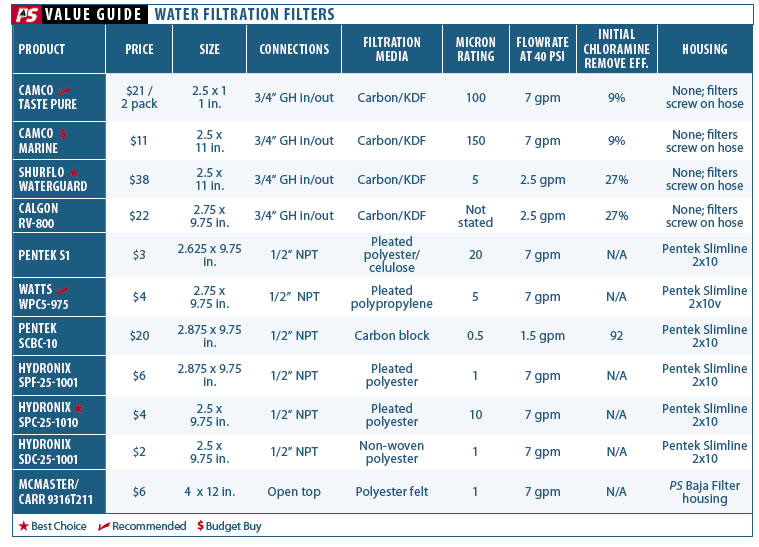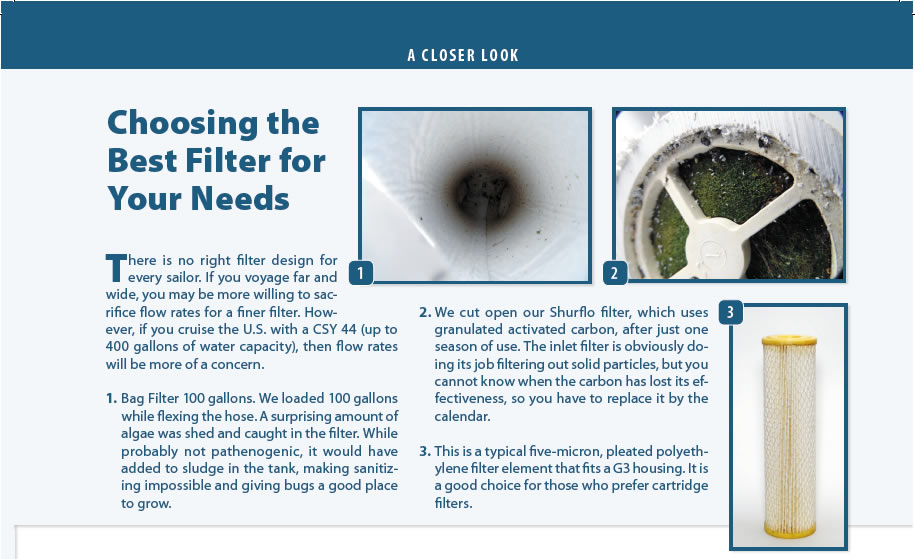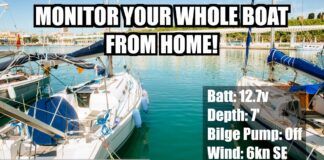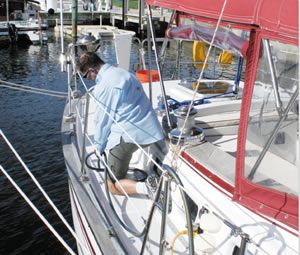
You would think that with all the emphasis cruising sailors put on their boats and equipment, we would pay a little more attention to ensuring a clean and safe supply of water. This is less a concern in developed countries, where dockside water is safely treated or bottled water is affordable and readily available. However, once you begin to expand your horizons, ensuring a clean water supply requires more thought and effort. This is the first report in a three-part series on equipment and practices that no matter where you and your boat are, you can be reasonably sure that your on-board water supply is safe.
In this first article, we explore how to prevent contaminants from entering your freshwater tank. In part two, we will look at chemical treatments that can be used to keep tank water fresh. And finally, well look at various filtration systems between the tank and faucet that keep tap water sweet and safe.
As people have become more conscious and sensitive about water quality issues, the market for products that promise to protect us from contaminants has blossomed. There are trade journals and associations dedicated to this sole topic: potable water filtration. Rather than attempt to provide a comprehensive overview of the field, weve narrowed our review to a few practical approaches and practical equipment. If you have come up with a system that you feel is novel and practical, write us with details at practicalsailor@belvoir.com; wed love to share them with our other readers.
Filtering Before the Tank
Many people don’t bother to filter their water before it goes into the tank. It doesn’t seem worth the trouble. But in many respects, this step is one of the most important. The first rule of sanitation is cleanliness. When significant accumulations of dirt and biomass are allowed to build up in the tank, no amount of disinfectant can reach the bugs buried underneath, and no final filtration system can make the water right again. Water-pump life is reduced by sediment, and fungal mats will clog your water lines.
Prevention comes in three parts. First, a boat that is stored for any significant period should have the water tank drained and dried; and the pipes should be filled with a bacteriostatic fluid. In cold climates, this will require a properly formulated winterizing solution (see PS, September 2014 online), and in warm climates, blowing out the lines with compressed air is good practice. What must be avoided is a poor winterizing fluid or one that is diluted; it will ferment, creating both solids and foulness. Secondly, an annual spring cleaning and disinfection (see PS, October 2013 online) can give you a fresh start, flushing out any accumulated biomass from the tank and piping. Third-the topic in front of us-we must keep out as much debris as possible.
Even when the dockside water supply is well supervised and safe, pipe scale and sediment can pass down the pipe, and algae will always grow in the hose. Another reason to filter at the inlet relates to final tap filtration; the incredibly fine (and relatively expensive) filters downstream that will catch giardia and cryptosporidium cysts will have much shorter lives if we use them to filter water that is laden with silt and biomass.
Filters can slow down filling, and whether you are in a hurry to head out or trying to clear the fuel dock for the next guy, excessive delay is intolerable. Any equipment used for filtering at the dock needs to be practical; its unrealistic to expect the freshwater tank to remain sterile for long, and certainly not with any level of filtration that is practical. Ultimately, we must settle for removing sediment and the larger clumps of biomass-and call it good.
What must we remove during dockside filtration? Presumably, you only accept water that is clear and contains very limited sediment. Cloudy water promises heavy microbe loads, is difficult to filter, and-without good filtration-proper purification is impossible; microbes can hide in the clay particles, evading any practical disinfection regiment. For clear water, we recommend a minimum of 10-micron filtration, which will catch course sediment, pipe scale, and larger clumps of algae that slough off the hose interior; this is easily accomplished with pleated elements or spiral-wound cartridges. Are you cruising remote areas where high-sediment water is unavoidable? Hauling jerry jugs from shore? Consider the one-micron, do-it-yourself Baja Filter (see PS, April 2015 online).
Filter Styles
Universal Cartridges
Universal cartridges promise ready availability through hardware stores worldwide, although you might not always find exactly what you want. The most common standard sizes are 2 by 10 inches, 2 by 20 inches, 4 by 10 inches, and 4 by 20 inches. The actual end-to-end-lengths are standard (4.875, 9.75, and 19.5 inches), but diameters vary slightly. Each end will have a gasket; they are generally open on both ends (so that they can be stacked), but some are closed on one end. You will not be bound to any proprietary design with a universal cartridge, and if some small part fails, many are either interchangeable or inexpensive.
Though 2-by-20 and 4-by-10 filters offer longer life and less flow restriction, for most applications, the 2-by-10 filters are the right choice. This is nice because they are also the most common, available in hardware stores worldwide.
Although universal cartridges are readily available and are relatively simple to integrate into dockside plumbing, we don’t see their merit. Generally, the water in the pipe to the dock is clean and safe; its the gunk growing on the hose were more concerned about. Theres no real harm in this setup (especially if youre a filter salesman whose route includes sailing clubs and marinas), but in order to be of real use, the filter needs to be at the boat-end of the hose.
Hose-End Filters
Hose-end filters offer great convenience and compact size for the smaller boat staying closer to home. The cost is slightly greater per unit of volume than that of a universal pleated filter, but no more than a universal granular activated carbon (GAC) filter of equivalent size, and they are much more compact and convenient. They are probably all that is needed for cruising in developed areas. If you are smart about where you buy them, they are economical, compact, and lightweight, and they offer more than enough capacity to get through the season.
While not as available in hardware stores, hose-end filters can be found at many online suppliers, and most marine and RV retailers carry them.
Unfortunately, there is little choice in filtration media-all are either GAC or GAC/KDM fill with fiber filters on each end-but that has proven satisfactory.
Does it matter that they remove beneficial chlorine? We tested a variety of hose-end filters, carbon block filters, and GAC cartridges; if the water flow is reduced to about 1 gallon per minute, as it would be during filter testing or at the water tap, they remove chlorine as designed; at full flow (4 to 7 gallons per minute) filling a tank, the filters will remove only about 15 to 35 percent of the chlorine. So, unless youre patient, don’t expect complete chlorine removal.
DIY Baja Filter
Practical Sailors do-it-yourself Baja water filter (see PS, April 2015 online) is perhaps the most versatile of the filters we looked at in terms of design. It filters to one micron, can be used on rainwater and jerry-can water, and it can even be laundered a few times.
The downsides? You have to make it yourself, and it is just slightly less convenient than a hose-end filter. This design is probably the most practical and effective on heavily contaminated water.
What We Tested
We looked at hose-end filters and universal cartridge filters. We have a lot of experience with hose-end filters. Tester Drew Frye (a chemical engineer who also blogs at www.sail-delmarva.blogspot.com) used three different models over the past seven years. His experience with cartridge filters spans 30 years of boating and industrial experience. He has found that it makes the most sense to stick with the most common universal sizes, and not to get lured into proprietary designs with special cartridge sizes and holders. He has seen too many designs become discontinued as the market changes and companies merge. Common filters are most economical for initial filtration.
Along with these common commercial products, we also tested our DIY Baja filter.
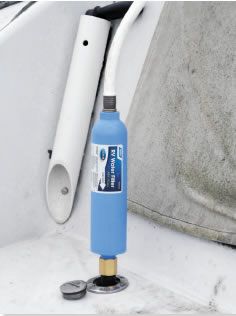
How We Tested
Our testing included four elements: basic observation, flow rates, chlorine removal, and filter dissection when expended. While it wasnt practical to perform detailed chemical analysis, we stayed with name brands and have learned that we can place at least some faith in industry ratings.
Many of these manufacturers also produce National Science Foundation (NSF) certified units. Those units are tested extensively, and so the manufacturers of these products have learned to rate units in accurate and consistent terms.
Observations
All of the hose-end filters produced less than 20 percent reduction in flow rate when new, adding very little to the restriction inherent in the hose and piping. Flow rates averaged about 6 to 7.6 gallons per minute (gpm), depending on the location. For comparison, when we installed a jet-stream nozzle on the same hose, flow was reduced from 7.6 to 3.7 gpm.
At the end of their useful life during field testing, the hose-end filters flow typically dropped to 4 gpm, although this was after several years of use. Normally, the filters would be replaced at more frequent intervals, well before flow was so restricted.
Most of this reduction in flow rate was attributed to fine sediment clogging the inlet filter. When we cut the hose-end filters open, the carbon was not clogged, nor was there much evidence of biological growth. We can only assume that the chlorination of the inlet water, combined with our habit of storing the filters vertically so that they could fully drain between uses helped prevent growth.
A key observation was that even when new, none of the filters removed a significant amount of chlorine-and by extension, probably didnt remove organics-at the rated flow rates. How could this be? A cursory review of carbon manufacturer design tables made it clear that it takes at least a few minutes of exposure to carbon for the chlorine to be removed from the water. At a flow rate of 7.6 gpm, the exposure (empty bed residence time) is only about 0.8 seconds. It takes time for the contaminants to diffuse over to the carbon, plus more time to diffuse into the pores; less than a second is not nearly enough.
Luckily, we didnt really want to remove the chlorine, so although the carbon filters function as nothing more than low-efficiency depth filters, were happy with that. However, this doesn’t blunt our ire toward filter vendors who tout these filters chlorine removal ability. (The next time that a water-filter salesman goes on and on about chlorine removal, ask how much chlorine is removed when the tap is flowing . . . and see what happens.)
One thing to expect with a granular activated-carbon filter is that fine bits of carbon will be expelled during the first fill, and-to a lesser extent-subsequent fills. Just flush for several minutes before filling. Flushing is a good idea, even if no carbon particles are showing up. Dockside hoses are untrustworthy and should be well flushed.

Universal Cartridge Filters: While we only tested one universal cartridge filter housing (Pentek Slimline 2 x 10) specifically for this article, weve used many brands in chemical process plants over the years and have experienced very few failures. All failures were easily avoided. Here are some vulnerabilities to be aware of:
Freezing: Any filter housing must be drained in freezing weather.
Hot water: Threads can fail; don’t filter heated water unless every portion of the systems is rated for the temperature.
UV damage: Clear plastic bowls are vulnerable to UV, and we see no advantage to them. They also encourage algae growth, and filter clogging is better gauged by flow rate than appearance. For dockside, opt for dark-color bowls; even they can fail after seven to 15 years of outdoor use.
In terms of connections, we like 3/4-inch National Pipe Thread (NPT) fittings as they are the easiest to adapt to a variety of plumbing types. We don’t like pressure-relief fittings or pressure gauges; they just present more potential for things to leak, fail, and cause installation space problems. While we did not experience any housing problems, we prefer simplicity.
Be sure to check O-ring position and coat the O-ring lightly with Vaseline. You can buy a plastic water-filter wrench for about $3 at most hardware stores, but if you forget or lose it, an oil filter wrench works fine. Replacement O-rings are about $3.
The upper and lower portions of the housings are sold separately, should you accidentally freeze one.
Cartridges: We tested nominal 2-by-10-inch cartridge filters; given typical marina piping and dock hose, larger filters would not have performed any better. However, it is safe to extrapolate the flow capacity of larger filters based upon these results.
A 2-by-20-inch filter will experience about half of the pressure drop of a 2-by-10-inch filter (not twice the flow rate since the housing entrance and piping provide an upper limit). It will last slightly longer than twice as long, since it has twice the holding capacity and twice the filter area.
Larger 4-by-20-inch filters are also available and will provide longer life for high-volume operations (someone washing a charter boat every day) but provide little added value for the typical sailor. Except for the carbon block filters, no filter caused measurable flow restriction when new.
Hose-End Filters
We tested a variety of hose-end filters. These make the most sense for sailors, since they filter water after it passes through the hose, which can be a source for contamination.
Camco RV Water Filter
This is a compact and convenient hose-end filter. Filled with a carbon/KDF blend, the filter provides good flow. It filters particles larger than 100 microns and can be used for 6,000 gallons (based on chlorine removal capacity).
We prefer finer filtration, but this filter is affordable and readily available. These are generally sold in pairs. We found a two-pack at our local big-box store for about $21.
Bottom line: Affordable and readily available, this is our Budget Buy, a good option for a U.S.-based sailor who will be replacing the filter once a year.
Camco TastePure
The Camco TastePure RV and Marine water filter is very similar to the other Camco filter, but it has a white body. Although the filtration rating is 150 microns, testers didnt notice any difference when comparing fine particle removal. Testers noted the same flow and same chlorine removal.
It appears that the main difference between the two Camco filters is in the packaging. You can get better chlorine removal if you slow down, but chlorine is an asset when it comes to keeping tanks fresh.
These filters come out a little more expensive, selling for about $12 each.
Bottom line: The TastePure is a little more expensive than the other Camco filter, and worth getting if you only want one filter. Recommended.
Shurflo Waterguard Filters
Shurflos Waterguard filters, made by Pentair Residential Filtration, have improved construction and better filtration, making them a premium product. Like most other filters in this category, these are also filled with a carbon/KDF blend, but the Waterguard filters provide slower flow rate due to finer filtration (5 microns). Finer filtration means less chance of biological growth, and we like that, but whether this is acceptable may depend on your tank size.
At $37 each, these are not cheap, but they last about two years.
Bottom line: This is the Best Choice for the off-the-shelf, hose-end filtration. The flow rate may be too slow for some sailors, particularly those with larger tanks.
Culligan RV-800
The Culligan RV-800 is the only hose-end filter we reviewed that is certified by the National Science Foundation (NSF). The performance was similar to the Shurflo Waterguard. For NSF approval, the chlorine removal efficiency is required to be 25 percent. In order to meet this standard, the Culligan unit restricts flow rates to 2.5 gallons per minute. There is no micron rating.
In theory, these units need to be replaced at shorter intervals, but only if you care about staying within the conservative NSF rating procedure.
These were less expensive than the SHURflo filters we tested, costing about $27 each.
Bottom line: If you are a stickler for staying within the NSF guidelines, worry about over-chlorinated water, and can live with slower flow rates, this filter will be a good choice.
Universal Cartridge Filters
We looked at five different universal filter cartridges. Except as otherwise noted, the housing we used for testing was a 2-by-10 Pentek, with a half-inch female NPT fitting rated for 120 psi (part #158648). It sells for about $12.
Pentek S-1
The Pentek S-1 20-micron polyester/cellulose pleated element filter provided good flow and appropriate filtration. It is not recommended for well-water or intermittent flow because the cellulose element will allow bacterial growth and will rot.
We included this as an example of what not to buy. Use only cellulose-free elements in marine applications.
Bottom line: Not recommended.
Pentek SCBC-10
The lone carbon-block filter in the lineup, the Pentek SCBC-10 is silvered to reduce bacterial growth and is rated at 0.5 microns. It was included to illustrate why it is wrong for the application. While this is a very good product and a good choice for final filtration at the tap (which we will address in a later article), it has low flow rate, high cost, and will plug much more quickly than pleated elements due to limited surface area.
This is the sort of filter one might use as a second stage if filtering water of doubtful quality; you would expect slow going (1.5 gpm at best) and limited life. Cost is about $20 each.
Bottom line: This product is not recommended for inlet filtration. Look for our upcoming review of tap filters for details on this application.
Watts Filtration WP5-975
A 5-micron, pleated polypropylene element, the Watts WP5-975 offers good flow, fine filtration, and long life. It is commonly used in reverse osmosis systems. Although it will clog more quickly than courser elements, the larger area of a pleated element should still last you through the season. Price is about $4.50 each.
Bottom line: Available at a variety of online sources, the Watts is Recommended for those who demand fine filtration.
Hydronix SDC-25-1001
A value-priced product, this is the only filter we tested that produced a complete failure due to bypassing. We tested two separate units, and 20- to 40-micron material continued to slide by this one-micron-rated filter. In an effort to save a few pennies, the maker skipped the end gaskets, depending instead on the non-woven material to scrunch and seal to the housing.
We were surprised to see such a complete failure in an NSF-certified filter, but a little investigating revealed that the certification was for materials and lead-free only; it is not certified for performance. A perfect example of why you need to know the details, and not simply accept the NSF stamp as proof of value. These run $2 each.
Bottom line: Dont buy a cartridge filter lacking substantial gaskets.
Hydronix SPC-25-1010
A 10-micron pleated polyester element, the Hydronix SPC-25-1010 represents the optimum compromise of flow, filtration, and usable life. Molded end caps serve as gaskets, a much better arrangement than the 1001 no-gasket system, at some increase in cost.
There are many sediment filters in this product lineup; just match the specifications and make certain there is a substantial gasket.
Bottom line: A good balance of priorities-flow, filtration performance, and life expectancy-the Hydronix SPC-25-1010 is our Best Choice for a cartridge filter.
DIY Baja Water Filter
For the sailor expecting to fill from jerry cans or rain water, this is the simplest method, but youre going to have to build your own. For details and a how-to, see the April 2015 article.
It will set you back about $20 for parts and $7 for the replaceable bag-but it will last a long time. The one downside is that as it plugs, it will overflow water all over the deck unless the flow is reduced.
Bottom line: This is as easy to use as the hose-end filters. We Recommend it for long-distance cruisers.
Conclusions
Our experiment with the DIY Baja filter was enough to convince us that filtration while filling the tanks makes a real difference in tank sludge and hygiene. We don’t see any reason to install filters with more capacity than will be required in a year; in climates that winterize, the elements must be removed before winterizing, and in areas where you use them year-round, you should replace them on an annual basis anyway.
All of the recommended products are rated for more than 6,000 gallons, which represents 150 40-gallon fill-ups; more than any seasonal coastal sailor will need. Only a few units have a rated capacity of less than 7 gpm, and so long as you avoid carbon block filters and any filter rated finer than 10 microns, filling will not be significantly affected.
We like the hose-end filters for their sheer convenience. The $11 Camco RV Water Filter is cheap and simple. For live-aboard and long-distance sailors, universal pleated cartridges that offer 5- to 10-micron (2-by-10-inch cartridge) filtration are our first choice; in exchange for a bulkier housing, you get better filtration, more options, worldwide availability, and better long-term economy. Mount the filter on the boat end of the hose, not the dock end; the hose may be the greatest source of sludge.
While not as convenient, our do-it-yourself filter was a top performer, offering 1-micron filtration, high solids capacity, economy, and easy cleaning; its the best filter for rainwater and jerry can water.
In the next article in this series, we will explore maintaining the quality of the water in the tank. In the third installment, we will present some lower cost options for final tap filtration, as well as some very high-quality microbiological purifiers. Stay tuned. If you have some novel solutions we should test, send your ideas to practicalsailor@belvoir.com.
